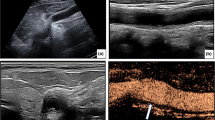Summary
We reviewed retrospectively 126 (5 male, 121 female) patients suffering from Takayasu arteritis who had been treated in our clinics from 1971 to 1990. The patients' ages ranged from 19 to 80yrs old (1990) with a mean age of 48.7 ± 11.8 years. HLA typing analysis in 98 patients revealed that 45 patients (47%) were confirmed as carrying the Bw52 antigen, a high result that is statistically significant as compared with that in healthy Japanese. Arteriograms (performed in 75 patients) revealed that 28 patients (37%) were affected in the aorta and its main branches by this disease (type IV by Nasu's classification) and 23 patients (31%) were affected only in the main branches (type I). The C-reactive protein (CRP) and erythrocyte sedimentation rate (ESR) improved significantly from 2.55 ± 0.28(+) and 57.0 ± 5.69 mm/hr to 0.53 ± 0.12(+) and 31.2 ± 3.45 mm/hr, respectively after treatment including steroid and antiplatelet therapy (P < 0.01). Patients with Bw52 exhibited more severe inflammatory conditions than those without Bw52. Lung scintillations performed in 81 patients showed pulmonary arterial lesions in 50 patients (62%). Echocardiograms revealed aortic regurgitation (AR) in 44 patients (35%), with a significant difference noted between the Bw52 positive group and the Bw52 negative group [29/40 (73%) versus 11/47 (23%), respectively,P < 0.001]. Patients with Bw52 were prescribed higher doses of steroids (P < 0.05) for longer periods (P < 0.01) than those without Bw52. Of 11 patients who died during our study period, 7 died of cardiac complications, all of whom were suffering from AR. HLA analysis performed in 6 of these 7 patients revealed that all carried the Bw52 antigen. In conclusion, the retrospective survey revealed that patients carrying the Bw52 antigen showed more severe inflammatory conditions and progressed more rapidly to complications and the fatal morbid condition, as compared with those without Bw52. This suggests the important role of gene disequilibrium with this HLA antigen.
Similar content being viewed by others
References
Lupi-Herrera E, Sanchez-Torres G, Marcushamer J, Mispireta J, Horwitz S, Vela JE (1977) Takayasu's arteritis. Clinical study of 107 cases. Am Heart J 93:94–107
Ishikawa K (1978) Natural history and classification of occlusive thromboaortopathy (Takayasu's disease). Circulation 57:27–35
Subramznyan R, Joy J, Balakrishnan KG (1989) Natural history of aortoarteritis (Takayasu's disease). Circulation 80:429–437
Numano F (1979) Pulmonary changes in Takayasu's arteritis (in Japanese). Cardioangiology 6:97–108
Cipriano PR, Silverman JF, Perlroth MG, Griepp RB, Wexler L (1977) Coronary arterial narrowing in Takayasu's aortitis. Am J Cardiol 39:744–750
Lupi-Herrera E, Sanchez-Torres G, Horwitz S, Gutierrez FE (1975) Pulmonary artery involvement in Takayasu's arteritis. Chest 67:69–74
Nasu T (1982) Takayasu's truncoarteritis-pulseless disease on aortitis syndrome. Acta Pathol Jpn 32 (Suppl 1):117–131
Ishikawa K (1986) Patterns of symptoms and prognosis in occlusive thromboaortopathy (Takayasu's disease). J Am Coll Cardiol 8:1041–1046
Ministry of Health and Welfare (1975) Clinical and pathological studies of Takayasu disease. Committee report. Ministry of Health and Walfare, Tokyo
Numano F, Isohisa I, Kishi Y, Arita M, Maezawa H (1987) Takayasu's disease in twin sisters: possible genetic factors. Circulation 58:173–177
Numano F, Ishohisa I, Maezawa H, Juji T (1979) HLA antigens in Takayasu's disease. Am Heart J 98:153–159
Isohisa I, Numano F, Maezawa H, Sasazuki T (1978) HLA-Bw52 in Takayasu disease. Tissue Antigens 12:246–248
Sasazuki T, Ohta N, Isohisa I, Numano F, Maezawa H (1979) Association between Takayasu disease and HLA-DHO. Tissue Antigens 14:177–178
Isohisa I, Numano F, Maezawa H, Sasazuki T (1982) Hereditary factors in Takayasu disease. Angiology 33:98–104
Numano F, Ohta N, Sasazuki T (1982) HLA and clinical manifestations in Takayasu disease. Jpn Circ J 46:184–189
Ishikawa K (1988) Diagnostic approach and proposed criteria for the clinical diagnosis of Takayasu's arteriopathy. J Am Coll Cardiol 12:964–972
Kozuka T, Nosaki T (1969) Aortic insufficiency as a complication of the aortitis syndrome. Acta Radiol [Diagn] (Stockh) 8:49–53
Morooka S, Takeda T, Saito Y, Nonaka Y, Maruo S (1981) Dilatation of the aortic valve portion in aortitis syndorome — Angiographic evaluation of 70 patiens. Jpn Heart J 22:517–526
Sasazuki T, Grumet FC, McDevitt HO (1977) The association between genes in the major histocompatibility complex and disease susceptibility. Ann Rev Med 23:425–452
Park JH, Han MC, Kim SH, Park YB, Seo JD (1989) Takayasu arteritis: Angiographic findings and results of angioplasty. Am J Rad 153:1069–1074
Hong CY (1990) Takayasu arteritis in Korean children. The IInd Japan-Korea Cooperative Survery on Takayasu Arteritis, Seoul, February 2–3
Author information
Authors and Affiliations
Rights and permissions
About this article
Cite this article
Moriwaki, R., Numano, F. Takayasu arteritis: Follow-up studies for 20 years. Heart Vessels 7 (Suppl 1), 138–145 (1992). https://doi.org/10.1007/BF01744560
Issue Date:
DOI: https://doi.org/10.1007/BF01744560




